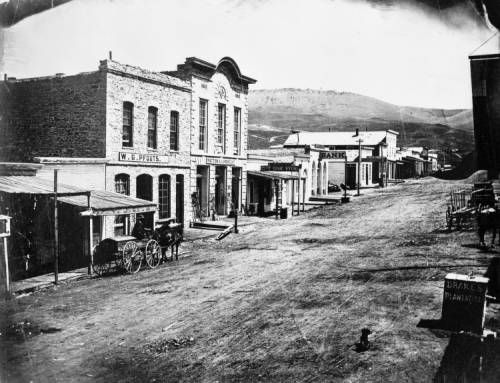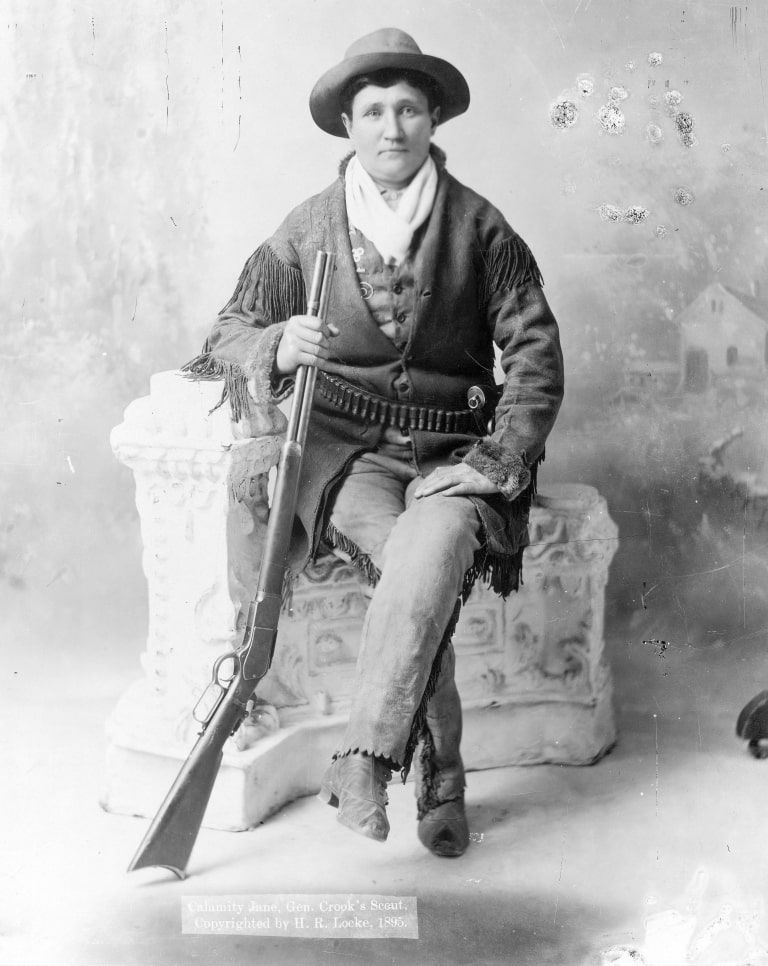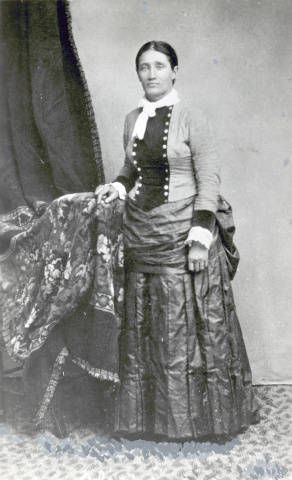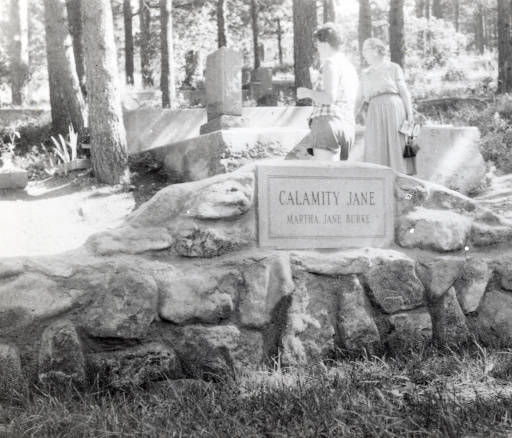The Lovely Lady Calamity Jane
- Liz Bowers
- Aug 19, 2020
- 5 min read
Updated: Nov 22, 2020
Originally published as "Calamity Jane Earns Her Name" in the Buffalo Center of the West Staff blog May 23, 2019.
The sour smell of mingling wood and coal smoke settled in the frigid damp Montana morning air. Two little girls made their way down the street, their eyes lowered. Although the harsh cold winter had settled on the Virginia City streets, the girls were clothed only in shabby calico cloth, the mud sucking at their bare toes, and the wind striking their chapped skin. The eldest girl carried a small infant in her boney arms.
They stopped at the door of a Mr. Fergus, a commissioner of Madison County whose job it was to care for the poor. His wife and a few other kind ladies provided them food and clothing. The girls again made their way back through the unforgiving streets to the mining town of Nevada, Montana. There their father gambled, and their mother was referred to as “a woman of the lowest grade.” Not long after that, the unfortunate woman died.

We know relatively nothing of what happened to all but the eldest girl. Her father traveled with her to Salt Lake City where he eventually died as well. There are many stories – which cannot be confirmed – as to what then became of this pitiful child. Most say she was simply on her own.
Is it any wonder then that she came to be known in womanhood as that infamous plainswoman Calamity Jane?
Known for dressing in men’s clothing, riotous behavior, and tall tales larger than the dime novels could convey, Calamity became a woman shrouded in mystery. Curious seekers looking back try to sort out the truth from fiction about her life. Was she Wild Bill’s one true love? Did she kill as many Indians as any man ever had? Did she scout for the ill-fated General Custer?

All sources agree, Wild Bill Hickock knew her for only a few short weeks before his death and paid her very little heed. He did note, as did all her other acquaintances when it came to drinking, “she hit it more often than anyone else.” As for vocabulary, “she had a wonderful command of profanity.” On whether or not she was an Indian fighter or scout, those present claimed these yarns to be pure fantasy. If she was there at all, it was as a camp follower. In fact, General Crook who she was mythically a scout for, turned her away from camp during the Jenney Expedition from Fort Laramie to the Black Hills once he discovered her presence there as a camp follower.

Sure, Calamity could be found wherever men would congregate, be it the saloon, the mines, or the army camps but it wasn’t for adventure or courageous deeds. Following the rails of the Great Northern Pacific, she found her place among other camp followers like “Mag&Moll, gentle Annie, Moss Agate, the Schoolmarm, and Mormon Ann.” From railroad towns to mining camps and army forts, she took opportunities where they came.
It's rumored that she even spent some time in our favorite Wyoming Gold Rush towns, South Pass City and Miner's Delight!

How does a woman such as Calamity become a “Hero of the Plains?” Her adventures were embellished, invented, and preached as fact by sensationalist journalists from all over the country. After all, a pitiful girl in calico doing whatever was necessary to survive, wasting away from a life of alcoholism and prostitution is hardly a story any of us would want of the West however realistic it may be.
However true or false the legends of her life seem to be, Calamity Jane didn’t mind in the least that she profited by them and became a beloved dime-novel caricature. Writing her own Life and Adventures by proxy, she wrote in the myths right along with the true accounts.
Finally, someone stepped forward to set the record straight: Captain Jack Crawford, “The Poet Scout,” contributed to some extent in his own writings to the legend of Calamity Jane. After her death, Crawford wrote an article titled The Truth About Calamity Jane.

In a tirade regarding the yellow journalism of the day that so distorted the lives of frontier people such as Calamity Jane, he wrote, “Women have been glossed over with a glamour of romance, whose lives, in reality, were wretched and dissolute and in consequence many a young girl who has started out in the world full of lofty ideals and high aims, fired by the illusion that has been placed before her in the papers and books, end, like the subject of the story herself (if the truth were told), in shame and sorrow.”
It was not that he did not recall his old acquaintance with Jane fondly, he simply wasn’t going to call fiction true when in his opinion such deception was actively ruining the lives of the nation’s young people! He went on to write, “Calamity Jane was a good-hearted woman and under different environments would have made a good wife and mother, but she was born in the wilds of a mining camp with not a hand raised to protect her, until too late. Her father was a dissipated soldier and her mother careless, allowing Martha to grow up in a wild, unnatural manner, which we wonder did not quench out every spark of womanhood in her, and it is to her credit that she did retain a kind and generous heart even while following in the footsteps of her dissolute father and careless mother.”
Among all these myths, the towering image of a woman bent on surviving whatever life had to throw at her stands tall above the plains. We can make no account of her many “lovers” or of the many stories she told to wide-eyed campfire admirers. Calamity herself obscured these details.
You can imagine that, at the end of her life, she was a force of nature. But much like the shriveled trunk of an ancient tree with shallow roots, she must have swayed and rattled in the western wind. Her hands bright red, raw and calloused from years of laundering, menial labor, and bar fights. Her hair dark, thin, and reedy as it had ever been. Maybe in the spark of her eye, you would see a beauty that once had been. Like the dark fictional figure of Ebeneezer Scrooge emptying a street of its friendly inhabitants with his mere presence, you can imagine the boardwalk echoing with the sound of her feet alone.
It cannot truly be said that Martha Jane Canary Burke was missed by many when she was gone but the nation would never forget the woman who outshone men in acts of outrageous bravery – and could not but love the infamous Calamity Jane.

In honor of Calamity Jane: Born May 1, 1852, in Princeton, Missouri Passed August 1, 1903, in Terry, South Dakota Buried in Mount Moriah Cemetery Deadwood, South Dakota
RESOURCES
McLaird, James D. Calamity Jane The Woman and the Legend. Norman, OK: University of Oklahoma Press, 2005. McLaird, James D. Wild Bill Hickok & Calamity Jane Deadwood Legends. Pierre, SD: South Dakota State Historical Press, 2008. Jack Crawford Article: http://cdm17097.contentdm.oclc.org/cdm/singleitem/collection/CJC/id/37140/rec/22

留言